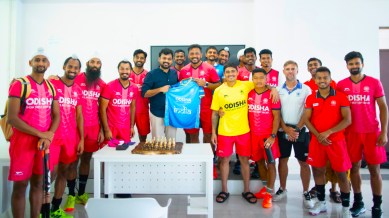Why Indian Hockey Team got a chess masterclass from American Gambits co-owner Prachura P Padakannaya
During the session, Prachura explained the nuances of the sport of 64 squares besides also playing a game against midfielder Vivek Sagar Prasad, who was aided by India captain Harmanpreet Singh, who plays chess with his wife when he is back home on a break.

The Indian men’s hockey team was given a unique chess masterclass by Prachura P Padakannaya, a co-owner of the American Gambits franchise in the Global Chess League, in a first-of-its-kind initiative on Friday. This is part of Indian hockey team coach Craig Fulton’s initiatives to get the hockey team to expand their horizons and move out of their comfort zones. During the session at the Sports Authority of India (SAI) campus in Bengaluru on Friday, Prachura explained the nuances of the sport of 64 squares besides also playing a game against Indian midfielder Vivek Sagar Prasad, who was aided by India captain Harmanpreet Singh, who plays chess with his wife when he is back home on a break.
The session was designed to help players think more clearly and make sharper decisions by drawing correlations from chess to hockey. Prachura drew parallels between chess and hockey, explaining how one person being out of position on the hockey pitch was like misplaying a move in the opening phase. Prachura highlighted how principles such as planning, anticipation, positioning and patience can be applied effectively on the hockey field. Using video examples from actual game situations, he demonstrated the importance of foresight, calculated risk and mental discipline in a competitive sport.
monthly limit of free stories.
with an Express account.
As part of the session, Prachura broke down the three key phases of chess: opening, middle-game and the endgame. He explained how the opening is about making the right moves at the start to build a strong foundation similar to hockey getting off to a good start. The middlegame, where the biggest battles are fought, drawing parallels with the importance of controlling the midfield in hockey to forge success in their attack. Finally, the endgame, where precision and mentality decides the outcome of the result, was likened to a striker finishing off a move in hockey. Here, Prachura showed the highlights from India’s Tokyo Olympics Bronze-medal outing — calling it the perfect endgame — where the Indian team held their nerves to defend 5-4 against Germany despite their opponents getting a penalty corner in the last six seconds of the game.
He further explained the roles of each chess piece and related them to hockey positions: pawns acting as the first line of defence, rooks and bishops creating structure and movement, knights surprising opponents with unexpected moves while the queen embodying versatility and dominance.
Reflecting on his interaction with the team, Prachura said, “The progression in both games is very, very similar. My experience here was fantastic because I never expected them to be so curious and engaging for a chess session. They were very inquisitive about the different formats in chess, how one needs to think seven-eight moves ahead and they were also quite amused to see how calm Gukesh’s heartrate was when I played the video of his recent match against Hikaru.
Even before the session began, they were interacting with me and were talking about what they do off the field and in their free time. It was nice to know at least half the team has played chess either with their family or teammates. It was a great experience to have and always a pleasure to interact with the best sportsmen of the country.”
Adding to the fun-and-engaging session, Prachura also invited the players for a friendly game of chess and Indian midfielder Vivek Sagar Prasad was the first to lift his hand up for the challenge. He was partnered by Captain Harmanpreet Singh, who plays chess with his wife when he is back home on a break. The rest of the team, cheered the duo on.
Sharing his thoughts, Vivek said, “It was a very insightful chess masterclass and we are grateful that Prachura made it so interesting by drawing similarities between the two sports. It was a learning experience, usually in hockey we have to think two-three moves ahead but in chess they are thinking seven-eight moves ahead and that’s something I would like to work on personally on my game.”
Relating chess to his role in hockey, he said, “Like on the chessboard, I see myself as both the knight and the queen. The knight’s unpredictability and the queen’s freedom to move anywhere reflect my role as a midfielder. Just like them, I cover the field from attack to defence, stepping in wherever the team needs me.”
Adding to Vivek’s views, Harmanpreet said, “As elite athletes, we always have something new to learn from another sport. We learn many new facets of chess today and certainly more such engaging sessions will only help us have a holistic approach to our game and think differently.”
Indian men’s hockey chief coach Craig Fulton praised the initiative, stating, “Every game has a strategy and chess is one of the best ways to learn how to think several steps ahead. In hockey too, if you start with the wrong setup, you open yourself up to mistakes, it’s about getting the foundation right, adapting in the middle and finishing strong. That connection between chess and hockey was clear today. It was also encouraging to see how engaged the players were and I believe sessions like this will not only sharpen their decision making but also keep them positively occupied in their free time. Who knows, maybe we’ll even have an intra-squad chess tournament one day.”